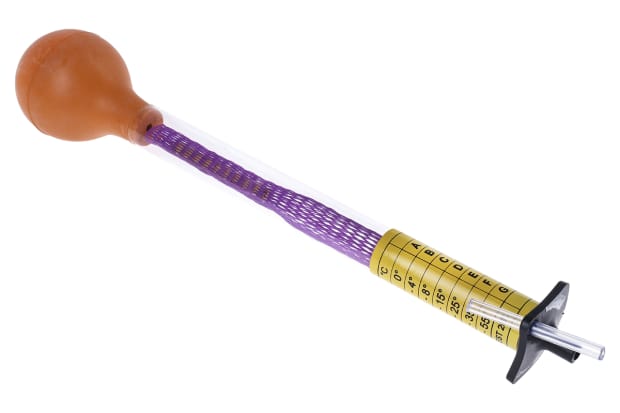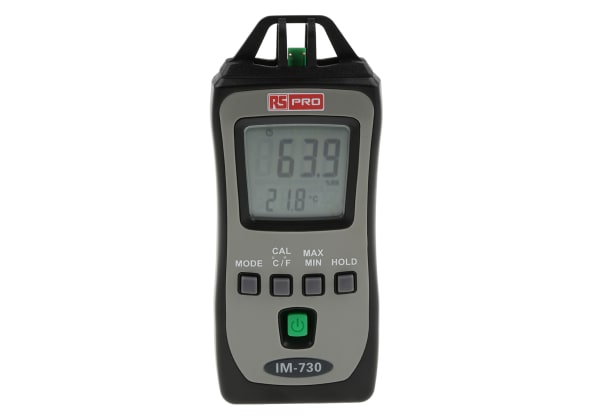- Published 28 Jun 2023
- Last Modified 29 Aug 2023
- 7 min
What is a Hydrometer and What is a Hydrometer Used for?
Dive into our comprehensive guide to master the art of hydrometer use, reading, and application across a wide range of industries.

A hydrometer is a vital instrument used in various industries, notably the brewing, distilling, winemaking, and marine sectors. Essentially, it is a scaled device designed to measure the density or specific gravity of liquids compared to the density of water. The invention of the hydrometer dates to the late 4th century and is attributed to Hypatia of Alexandria, who invented the hydrometer. Since then, its application has steadily evolved, making it an indispensable tool in various commercial applications.
How to Use a Hydrometer
Using a hydrometer is a straightforward process that involves submerging the instrument in the liquid you intend to measure. The hydrometer will float at a level directly proportional to the liquid's specific gravity. However, obtaining a correct and precise reading requires following a series of well-defined steps:
- Clean and dry your hydrometer: Before each use, make sure your hydrometer is clean and dry. This will prevent contamination and ensure accurate readings
- Draw a sample: Use a clean container to draw a sample of the liquid you wish to measure. The container should be wide and deep enough to allow the hydrometer to float without touching the sides
- Check the temperature: Hydrometers are usually calibrated for use at specific temperatures, typically around 20 degrees Celsius. If your sample is not at the calibration temperature, you'll need a hydrometer calculator to adjust your reading
- Submerge the hydrometer: Slowly lower the hydrometer into the liquid. Twist it gently to dislodge any bubbles that may cling to it, as these can affect your reading
- Read the hydrometer: Once the hydrometer stabilises, take your reading at the liquid's surface level
- Record your results: Jot down your results immediately after the reading. These will be crucial for calculations, comparisons, and creating a hydrometer reading chart over time
What Does a Hydrometer Measure?
A hydrometer is used to measure the specific gravity (SG) or density of a liquid. It's especially relevant in winemaking, brewing, and distilling, where it measures the sugar content in a liquid. The measured sugar level helps determine the potential alcohol content after fermentation. Therefore, you'll often find guides on how to use a hydrometer for wine or how to read a hydrometer for beer.
This seemingly simple data point provides valuable insights into the characteristics of the liquid being measured. It is crucial for several commercial and industrial applications:
- In the brewing, winemaking, and distilling industries, a hydrometer is used to determine the sugar content in a liquid. This indicates the potential alcohol content post-fermentation. Yeast consumes sugar during fermentation, and it produces alcohol and carbon dioxide. By tracking the reduction in sugar (and the corresponding increase in alcohol) through sequential hydrometer readings, these professionals can accurately gauge fermentation progress and efficiency. This information is vital for consistency in product quality and taste, making the hydrometer a key tool for these industries
- In the marine industry, hydrometers measure seawater salinity and specific gravity. This data is critical for various marine applications including navigation, marine biology, and oceanography. For instance, seawater's specific gravity impacts the buoyancy of ships and submarines. Understanding this factor is crucial for their safe and efficient operation
- Hydrometers are also used in the automotive industry to measure battery acid density. This helps determine the charge level of a lead-acid battery, which is a necessity for maintaining optimal battery performance and longevity
- In the food and beverage industry, hydrometers are used to measure sugar content in solutions like juice, syrup, and honey. This can help producers ensure product consistency, control sweetness levels, and even comply with food labelling regulations
- In scientific research and laboratory settings, hydrometers can be used to measure the specific gravity of a variety of fluids. This enables accurate and repeatable experiments, research, and testing
Even though a hydrometer measures a straightforward physical property, the interpretation of this measurement in context is what offers insight and utility across a wide range of industries.
How Does a Hydrometer Work?
A hydrometer works on a principle known as Archimedes' principle or the principle of buoyancy. According to this principle, an object submerged in a fluid experiences an upward force equal to the weight of the fluid it displaces. The denser the fluid, the greater the volume of fluid displaced and consequently, the higher the hydrometer floats.
When you place a hydrometer in a liquid, it will sink until the weight of the liquid it displaces equals its own weight. The denser the liquid, the less the hydrometer sinks. Conversely, the less dense the liquid, the more the hydrometer will sink.

A standard hydrometer is composed of a stem and a bulb. The stem is a narrow, vertical tube, often graduated with one or more scales to provide a numerical reading. The bulb at the bottom end of the hydrometer is weighted to float upright. It helps to displace more liquid, amplifying the effect of changing liquid density on hydrometer buoyancy.
For instance, if a hydrometer is placed in water, it will sink until the point on the stem aligns with the water's surface level. This level is typically marked as 1.000 on the specific gravity scale. This represents the density of water at a specific temperature, usually 4 degrees Celsius where water is at its densest.
When the same hydrometer is placed in a denser liquid, such as a sugar solution or a strong alcoholic spirit, it will float higher. The point where the liquid surface intersects the stem will be above the 1.000 mark. Conversely, if it's placed in a less dense liquid, such as petrol or light beer, it will sink deeper. The intersection will be below the 1.000 mark.
More advanced hydrometers, like the digital hydrometer, use electronic sensors to measure liquid density. These hydrometers offer a digital reading, which can increase the speed and accuracy of the measurement process, particularly in industrial applications where a high degree of precision is required. Digital hydrometers are also less influenced by external conditions such as temperature and are easier to read. This makes them a popular choice in many industries.
How to Read a Hydrometer
Reading a hydrometer correctly is crucial for accurate measurement interpretation. Below is a step-by-step guide:
- Observe the meniscus: After submerging your hydrometer, you'll notice that the liquid surface curves up the stem, forming a meniscus. Always read the bottom of the meniscus at eye level to eliminate parallax error
- Read the scale: Depending on the specific application, your hydrometer might have different scales, such as specific gravity (SG), potential alcohol (%ABV), or Brix (sugar content). Take your reading directly from the appropriate scale
- Consider the sample temperature: If your liquid sample isn't at the calibrated temperature (commonly 20 degrees Celsius), adjust your reading using a hydrometer calculator or a temperature correction table
- Record the reading: It is always good practice to document your readings for future reference, particularly in commercial applications where maintaining a hydrometer reading chart could be advantageous
Summary
In summary, a hydrometer is a versatile instrument with a wide range of applications in different sectors. Whether you're a seasoned professional looking to fine-tune your process or just need some basic guidance, understanding how to take a hydrometer reading can significantly enhance your results. From manual hydrometers to advanced digital hydrometers, the choice of device depends on your specific needs and the level of precision required.


